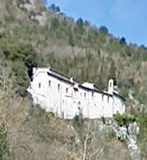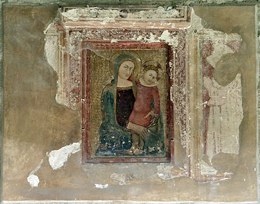


This site seems to have been the centre of an eremitical community from the 6th century. By the early 14th century, many of the hermits here were Franciscan tertiaries, popularly known as fraticelli. In 1342, Bishop Pietro Gabrielli built a hermitage here to bring them together, and to formally institute their community, which adopted the Augustinian rule. This foundation prospered, and it absorbed the diminishing canonical community at San Secondo in 1413, with the sanction of the anti-pope John XXIII.
In 1414, Beato Stefano Agazzari led a small group of canons from Lecceto in search of a place where they could follow an austere form of their rule, and they settled at Sant’ Ambrogio with the approval of Pope Gregory XII. In 1418, Pope Martin V prevailed upon the Bishop of Bologna to give them the church of San Salvatore in that city and Our Lady in Reno outside it. He recognised the new "Congregation of the Most Holy Saviour" and gave it the right to elect its own general. This became one of the two most important congregations of reformed canons (the other being he Congregation of Lateran Canons that was formed in 1446).
The church , which was remodelled in the 17th century, is in the form of an apse and transept.
Blessed Arcangelo Canetoli of Bologna (1460-1513)
The church contains the relics of the Blessed Arcangelo Canetoli of Bologna (1460-1513), whose family was wiped out in a feud with the Bentivogli family while he was still a baby. In 1484, he joined the Congregation of the Most Holy Saviour in Bologna, where he served as guest master, even welcoming his family’s murderers. In 1498, he was ordained a priest and moved to Sant' Ambrogio, where he spent the last years of his life as the superior of the community. Arcangelo predicted that Giovanni de’ Medici would be elevated to the papacy. When this happened in 1513, the new Pope’s brother, Giuliano de’ Medici called him to Florence and tried to persuade him to become the city’s bishop. Arcangelo refused, but died Castiglion Aretino on his way back to Gubbio. Giuliano de’ Medici gave the canons permission to translate his relics back to Sant’ Ambrogio. They were translated to their present site under the high altar in 1760. Arcangelo’s cell is preserved (but not visitable) on the first floor of the convent.
Church
Fresco [subject??] (14th century)
This fresco, which is attributed to Guido Palmerucci, is in the sacristy [not open].
Blessed Arcangelo in prayer (1797)
The canons of Sant’ Ambrogio commissioned this altarpiece for the high altar from Annibale Beni, who painted it in Rome.
Art from the Complex
Madonna and Child (15th century)

This small fresco, which is attributed to to Ottaviano Nelli, was detached in 1904 from the cell of the Blessed Arcangelo and is now in the Cappella di San Sebastiano behind San Secondo.
Baptism of St Augustine (1550)
This altarpiece, which is signed by Benedetto Nucci and dated by inscription, was stolen in 1984 from Sant’ Ambrogio. It was moved [where??] to San Secondo after its recovery in 1989. It depicts St Ambrose christening St Augustine, whose mother, St Monica, kneels on the left. The kneeling figure on the right is probably the Blessed Arcangelo Canetoli.

